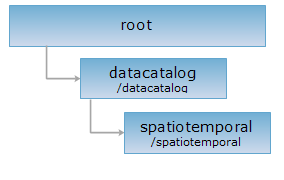URI
<datacatalog_uri>/spatiotemporal[.<format>]
Supported methods
Parent resource
Child resources
Introduction
The spatiotemporal resource represents the entry of spatial data resource. It can view the real-time data stored in iServer DataStore by the spatiotemporal resource.
Supported Methods:
- GET: Get the relevant sub resource list of the spatial data.
- HEAD: Checks whether the spatiotemporal resource exists or whether it has permission to access the resource.
Supported output formats: rjson, json, html, xml.
Resource hierarchy

HTTP request methods
Implement the HTTP request on the following URI, where supermapiserver is the server name, with rjson being the output format.
http://supermapiserver:8090/iserver/services/datacatalog/rest/datacatalog/spatiotemporal.rjson
GET request
Get the relevant sub resource list of the spatial data.
Request parameter
None
Response structure
GET request in spatiotemporal resource is a resource descriptive collection in the entity of response messaging, where the structure of a single resource description is as follows:
| Field | Type | Description |
| name | String | Sub resource name. |
| path | String | Sub resource URL. |
| resourceConfigID | String | The configuration item ID of the resource. |
| resourceType | String | The resource type. |
| supportedMediaTypes | String[] | The media-type of the supported representation. |
Response example
The returned rjson format representation after implementing the GET request on the spatiotemporal resource:
[{
"name": "datasets",
"path": "http://localhost:8090/iserver/services/datacatalog/rest/datacatalog/spatiotemporal/datasets",
"resourceConfigID": "datasets",
"resourceType": null,
"supportedMediaTypes": null
}]
HEAD request
Asks for the response identical to the one that would correspond to a GET request, but without the response body. This is useful for retrieving meta-information written in response headers, without having to transport the entire content. The meta-information includes the media-type, content-encoding, transfer-encoding, content-length, etc.
HEAD request can be used to check if the spatiotemporal resource exists, or if the spatiotemporal resource can be accessed by clients. It can also determine if the spatiotemporal resource supports an output format <format> if performed on a URI with .<format> included.